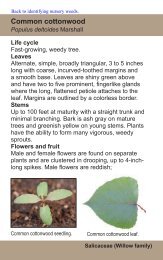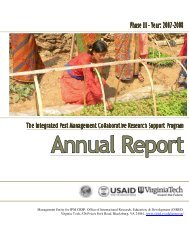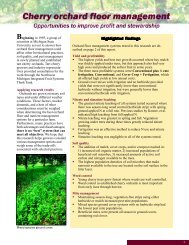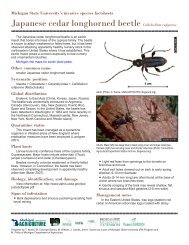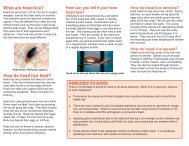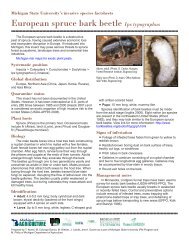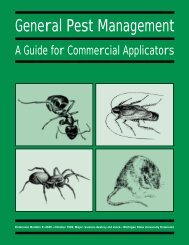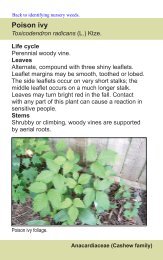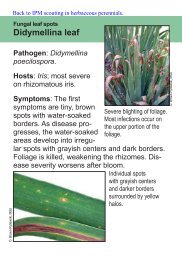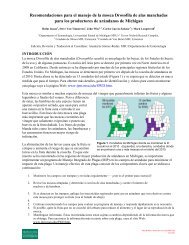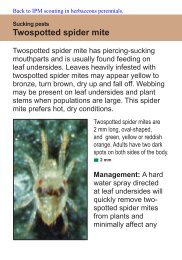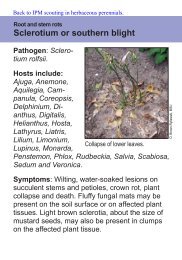Whole Manual - Michigan State University: Integrated Pest ...
Whole Manual - Michigan State University: Integrated Pest ...
Whole Manual - Michigan State University: Integrated Pest ...
Create successful ePaper yourself
Turn your PDF publications into a flip-book with our unique Google optimized e-Paper software.
CABBAGE MAGGOTS (Delia radicum)<br />
Cabbage maggot adults are flies that look very similar<br />
to houseflies. Cabbage maggots overwinter as pupae in<br />
the soil and emerge in spring. Immediately after emerging,<br />
the female flies begin to lay small, white, oval eggs at<br />
the bases of cole crop plants in or near the soil. Larvae,<br />
otherwise known as maggots for flies, burrow into the<br />
soil and attack plant roots. Cabbage maggots have many<br />
host plants, including crops (broccoli, cabbage) and<br />
weeds (wild mustard). There are three generations per<br />
year in <strong>Michigan</strong>.<br />
Damage: Cabbage maggots feed on young, susceptible<br />
transplants and seedlings in early spring, killing or stunting<br />
plants. On hot days, damaged plants may wilt.<br />
Cabbage maggot damage also creates an entrance for secondary<br />
infections such as bacterial soft rot and blackleg<br />
(See Chapter 7 – Disease Management). Cabbage maggots<br />
can be more of a problem in cool, wet weather.<br />
Control strategies:<br />
■ Plant wilt-resistant sweet corn hybrids.<br />
■ Avoid planting susceptible hybrids early in the season.<br />
■ Remove crop residue and control weeds to remove<br />
corn flea beetle overwintering sites.<br />
■ Areas where corn flea beetle and Stewart’s wilt have<br />
been a problem may require insecticide seed treatment.<br />
Foliar insecticides applied to control corn rootworm<br />
also offer some control of corn flea beetle. See<br />
Chapter 7, diseases of corn, for further information.<br />
EUROPEAN CORN BORER (Ostrinia nubilalis)<br />
Control strategies:<br />
■ Destroy crop residue to reduce overwintering cabbage<br />
maggot pupae.<br />
■ Plant cole crops after peak adult flight (mid-to late<br />
June) to reduce the number of eggs laid on the crop.<br />
■ Several natural enemies, including a parasitic wasp<br />
and a nematode, attack cabbage maggots. Ground<br />
beetles also eat cabbage maggot eggs. The natural<br />
enemy population does not usually provide adequate<br />
control in heavily infested fields, however.<br />
■ Scouting for adults or eggs of cabbage maggots is difficult.<br />
The adults look much like many other common<br />
flies, including houseflies. Eggs are very small and<br />
difficult to find in the soil. Therefore, preventive soil<br />
treatments are commonly used in areas where cabbage<br />
maggot has been a problem in the past.<br />
INSECT PESTS OF CORN (SWEET)<br />
CORN FLEA BEETLE (Chaetocnema pulicaria)<br />
The adult corn flea beetle is very small—1/16 inch<br />
long—shiny, and black, with enlarged hind legs. It jumps<br />
like a flea when plants are disturbed. In <strong>Michigan</strong>, flea<br />
beetles overwinter in plant debris along field edges. In<br />
the spring, they emerge and feed on grasses and winter<br />
wheat if no corn is available. Eggs are deposited in the<br />
soil, and the larvae develop in the soil feeding on corn<br />
roots.<br />
Damage: Adult corn flea beetles strip off the top layer of<br />
cells on a leaf, giving the leaf a scratched appearance.<br />
The most severe injury occurs during cold springs,<br />
when slow plant growth allows the beetle more time to<br />
feed. Corn flea beetles may also transmit a bacterial disease,<br />
Stewart’s wilt, which can dramatically reduce<br />
yields of susceptible hybrids. Disease symptoms may<br />
appear at any stage of corn development in certain corn<br />
varieties. (Refer to <strong>Michigan</strong> <strong>State</strong> <strong>University</strong> Extension<br />
Bulletin E-2034, Chapter 7, Field Crops—Disease, for<br />
more information).<br />
European corn borer larva (top) and adult (bottom).<br />
The European corn borer is the most serious pest of<br />
<strong>Michigan</strong> sweet corn. European corn borers overwinter<br />
as full-grown larvae in corn debris, usually field corn.<br />
Beginning in mid-June, the first generation of adult<br />
moths emerge and mate in tall grasses. The adult moths<br />
are cream to light brown. The female moth lays her eggs,<br />
which look like fish scales, on the undersides of corn<br />
leaves. The larvae hatch and feed on the leaf, eventually<br />
moving into and feeding down in the whorl. As the larvae<br />
mature, they enter the stalk to feed and pupate.<br />
Second-generation European corn borer adults mate and<br />
the females deposit eggs on the leaves in the ear zone of<br />
silking corn. The larvae feed on the developing ears,<br />
causing kernel damage, or enter the stalk, ear shank, or<br />
cob. Depending on the temperature, there are two or<br />
three generations of European corn borer per year.<br />
Vegetable Crop <strong>Pest</strong> Management 41<br />
Chapter 5



